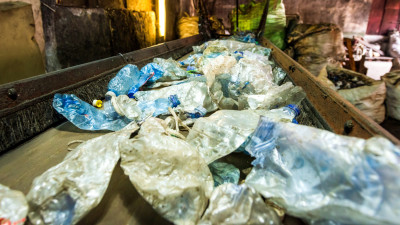With dramatically large amounts of clothing and other textiles being thrown out every year – nearly 10 million tonnes in the United States and more than 3 million tonnes in European Union (EU) countries – it is no wonder why designers and companies are increasingly looking to this waste as a potential resource.
Trending:
Levi’s, EU Project Unlock New Ways to Turn Textile Waste Into New Products
With dramatically large amounts of clothing and other textiles being thrown out every year – nearly 10 million tonnes in the United States and more than 3 million tonnes in European Union (EU) countries – it is no wonder why designers and companies are increasingly looking to this waste as a potential resource.
Designers, design researchers, scientists, raw-material suppliers and end-product manufacturers from across Europe are collaborating on a project called Trash-2-Cash. The project’s 19 cross-disciplinary partners from 10 countries are investigating techniques that can be used to spin, knit, sew or design innovative high-quality products from used textile fibres. Their efforts are being coordinated by the SP Technical Research Institute of Sweden.
The team aims to ‘design for recycling’ using existing waste streams – a critical challenge to address if we are to realize a circular economy for textiles. Their process began with material properties defined by designers, who are now collaborating with material scientists to evaluate newly developed eco-efficient cotton fibre regeneration processes and polyester recycling techniques. “Novel materials will be constructed – starting at the molecular level – in order to generate new textile fibres and other products that will be compatible with the environment for a sustainable future,” the project website explains. End-product manufacturers are also developing and testing prototypes to fit consumer needs in fashion, interiors, automotive, and “other luxury products.”
Recently, VTT Technical Research Centre of Finland and Aalto University announced a partnership under the Trash-2-Cash programme, aiming to develop ecological and efficient techniques for pre-processing and washing waste textiles, separating fibres, and fiberisation. VTT is focusing on breaking down the fibres in waste textiles and making them suitable for the cellulose carbamate process – which it has already begun testing through its Relooping Fashion Initative – while the Ioncell cellulose fibre manufacturing process will be carried out at Aalto University. They have found the process is able to produce high quality textile fibres even from low quality wastes.
“Turning unwanted textiles into raw materials for new textiles using ecological technologies provides an opportunity for revolutionising European textile manufacturing and trade,” said VTT's Research Professor Ali Harlin.
The Trash-2-Cash project was launched in June 2015 and will continue through 2018. The total budget is €8.9 million, of which EU funding accounts for €7.9 million. Trash-2-Cash is one of several circular economy-related projects being funded by the EU’s Horizon 2020 research and innovation program, including an €11 million textile-focused project called RESYNTEX. The European Clothing Action Plan (ECAP) aims to divert over 90,000 tonnes per year of clothing waste from landfill and incineration across Europe by March 2019.
Meanwhile, Seattle, Washington-based startup Evrnu has developed a new, patent-pending recycling technology to convert discarded consumer waste into ‘regenerated’ fibre. Earlier this month, Evrnu announced it had completed its first prototype pair of jeans in partnership with Levi Strauss & Co. (LS&Co.), in effect creating the world’s first jean made from regenerated post-consumer cotton waste.
The Levi’s® 511® jean prototype, developed by Evrnu and the LS&Co. innovation team, was created from approximately five discarded cotton T-shirts.
“This first prototype represents a major advancement in apparel innovation. We have the potential to reduce by 98 percent the water that would otherwise be needed to grow virgin cotton while giving multiple lives to each garment,” said Paul Dillinger, head of global product innovation at Levi Strauss & Co. “Although early days, this technology holds great promise and is an exciting advancement as we explore the use of regenerated cotton to help significantly reduce our overall impact on the planet.”
According to an LS&Co. lifecycle assessment, the cotton growing stage has the biggest impact on water use during the lifecycle of a pair of jeans, accounting for 68 percent of the total water used.
“By tackling water conservation through new fiber innovation, the apparel industry has the opportunity to significantly reduce its water footprint,” Dillinger continued. “As technologies such as Evrnu evolve over time, there will be greater opportunities to accelerate the pace of change towards a closed loop apparel industry.”
Evrnu Founder Stacy Flynn told Triple Pundit that she does not believe the market will move away from cotton, but expects her company’s technology to help both developed and emerging markets better manage available resources going forward.
“As emerging markets expand, we’ve got to get smarter to meet that need; that’s the biggest potential for regeneration of virgin materials,” she said. “The prediction is that apparel volume will double by 2025, and our current rate of resource extraction cannot meet this demand; this is a massive opportunity for emerging technologies that efficiently manage resources. The key is balance.”
Evrnu is currently the only American company working on such technology, but it is aware of competitors in the United Kingdom, Finland, and Sweden. Stockholm -based startup re:newcell, for example, has a similar technology that is able to turn jeans, t-shirts and other cotton garments into a new pulp for use in materials such as viscose or lyocell.
LS&Co.’s work with Evrnu builds on the company’s efforts to develop infrastructure for closed-loop products by 2020. Just last month, for example, the company announced a partnership with Italian upcyled fiber supplier Aquafil to create a new men’s collection incorporating nylon made from waste materials.








